 |
 |
 |
| |
Safety of Atazanavir (ATV) and ATV/Ritonavir (ATV/RTV) in Patients Co-infected With HIV and Hepatitis B and/or C: 1100 Patient-years of Treatment Exposure
|
| |
| |
Reported by Jules Levin
XVI IAC Toronto Aug 2006
Poster WE PE 0054
Witek J,1 McCallister S,2 Odeshoo L,3 Thiry A,3 Frederick D,3 Ledesma E,3 Hammond J3
1Bristol-Myers Squibb Pharmaceutical Research Institute, Plainsboro, NJ, USA; 2Bristol-Myers Squibb Pharmaceutical Research
Institute, Princeton, NJ, USA; 3Bristol-Myers Squibb Pharmaceutical Research Institute, Wallingford, CT, USA
Study objective: To evaluate laboratory and clinical data for hepatic parameters (AST, ALT, total bilirubin) and hepatobiliary AEs in patients with vs without co-infection from 4 prospective clinical trials (BMS Studies 089, 034, 043, and 045)
AUTHOR SUMMARY
Total bilirubin levels
- For ARV-naive patients (Study 089 and 034) and ARV-experienced patients
(Studies 043 and 045),Grade 3-4 total bilirubin elevation rates for subgroups
with and without co-infection were comparable
Relative to those without hepatitis co-infection, patients with hepatitis co-infection
had:
- Comparable rates of Grade 2-4 treatment-related AEs with the exception of
Study 043
ALT/AST levels
- For both ARV-naive and ARV-experienced patients, Grade 3-4 ALT/AST
elevation rates were higher for patients with hepatitis co-infection than for
patients without co-infection
- Comparable AE-related treatment discontinuation rates
- ARV-naive patients had comparable rates up to 76 weeks of follow-up
- ARV-experienced patients had comparable rates in more than 96 weeks of follow-up
- Lower rates of hyperbilirubinemia or jaundice
- Higher rates of ALT and/or AST elevations
Author Conclusions
These four studies in both ARV-naive and -experienced patients equal almost 1100
-- patient years of ATV or ATV/RTV treatment
In both ARV-naive and -experienced patients with hepatitis co-infection who received an ATV or ATV/RTV based regimen:
- There were higher rates of Grade 3-4 AST/ALT as compared with patients without hepatitis co-infection
- Grade 3-4 total bilirubin elevation rates were lower compared with those without hepatitis co-infection
These data suggest that ATV and ATV/RTV should both be considered safe treatment options in patients with hepatitis co-infection
- AEs and AE-related discontinuation rates in co-infected patients were low
Background
Patients co-infected with HBV and/or HCV may have a higher incidence of antiretroviral (ARV)-related hepatotoxicity1
- Co-infection with hepatitis B or C is common
- Up to 40% of co-infected patients on ARV may develop Grade 3-4 ALT or AST
elevations1
Significant liver enzyme elevations may be reported in about 15% of patients treated with ARV drugs2
Squires, et al. reported that one-third of ARV-naive patients on ATV-containing
regimens had Grade 3-4 total bilirubin elevations3
Elevated levels of bilirubin and jaundice are most often associated with ARV use (with jaundice occurring less frequently)4
- Hyperbilirubinemia is infrequently associated with treatment
discontinuation
Ritonavir has been associated with severe hepatotoxicity (Grade 3 or 4 ALT/AST
elevations) in HIV+ patients co-infected with hepatitis B or C5
ARVs (eg, non-nucleoside reverse transcriptase inhibitors) may be associated with clinically relevant hepatotoxicity in HIV+ patients co-infected with hepatitis B or C1
- The actual risk of hepatotoxicity varies by protease inhibitor (PI) being used and by hepatitis B or C co-infection status
Atazanavir is a potent, generally well-tolerated, once-daily (QD) PI and has been
extensively studied in ARV-naive and -experienced patients
ATV has a relatively low rate of ALT/AST elevations as compared with other PIs
ATV has been shown to be highly effective as a part of HAART regimens in multiple controlled trials conducted for up to 96 weeks
While short-term data suggest that ATV/RTV is well-tolerated in hepatitis co-infected patients,6 data on the long-term use of ATV in ARV-naive and -experienced patients with or without hepatitis B or C co-infection are limited
Methods
This was a post-hoc evaluation of data from patients with or without hepatitis B and/or C co-infection who participated in BMS Studies 034 and 089 (ARV-naive) and BMS Studies 043 and 045 (ARV-experienced)
In these 4 studies, ATV-based regimens were compared to alternative treatment arms
- Treatment arms for the studies were:
Study 089 - ATV vs ATV/RTV
Study 034 - ATV vs EFV (efavirenz)
Study 043 - ATV vs LPV (lopinavir)/RTV
Study 045 - ATV/RTV vs LPV/RTV
Patients were defined as having hepatitis co-infection at baseline if hepatitis B surface antigen or hepatitis C antibody present
This evaluation identified and compared the rates of ALT/AST elevations, total bilirubin elevations, and hepatobiliary AEs for subgroups of patients with or without hepatitis coinfection
Safety analysis included:
- Tabulation of related AEs (Grade 2-4)
- Laboratory abnormalities (Grade 3-4)
- Discontinuations due to AEs
RESULTS
Patients included:
A total of 858 patients received ATV-based regimens (ATV [n = 644],
ATV/RTV [n = 214])
- A total 263 patients received LPV/RTV-based regimens
Within the overall subpopulation of ARV-naive patients:
- 146 had HBV and/or HCV co-infection, while 844 were without co-infection
- 95 were on a boosted ATV regimen and 501 were on an unboosted ATV
- 394 patients were on EFV
The ARV-experienced patient population included:
- ATV-treated patients: 98 had hepatitis co-infection, 543 did not
- LPV/RTV-treated patients: 38 had hepatitis co-infection, 225 did not
- ATV/RTV-treated patients: 36 had hepatitis co-infection, 178 did not
A total of 231 (15%) patients within the overall population had baseline HBV and/or HCV co-infection
- 57 patients had baseline HBV co-infection and 179 had baseline HCV co-infection
(Sum of the HBV and HCV co-infection subgroups is > 231 as some patients had
both HBV and HCV)
Across the 4 component study populations, the mean duration of treatment ranged from 45 to 78 weeks, comprising 1100 patient-years of ATV treatment exposure
- Mean durations of treatment for the individual studies were:
Study 089 - 50 weeks for both arms
Study 034 - 73 weeks for ATV, 68 weeks for EFV
Study 043 - 60 weeks for ATV, 45 weeks for LPV/RTV
Study 045 - 78 weeks both ATV/RTV, 68 weeks for LPV/RTV
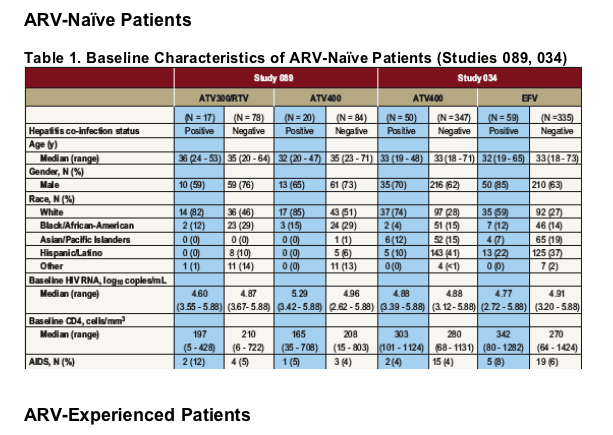
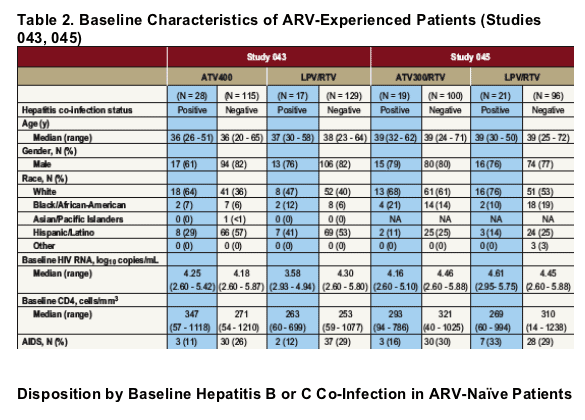
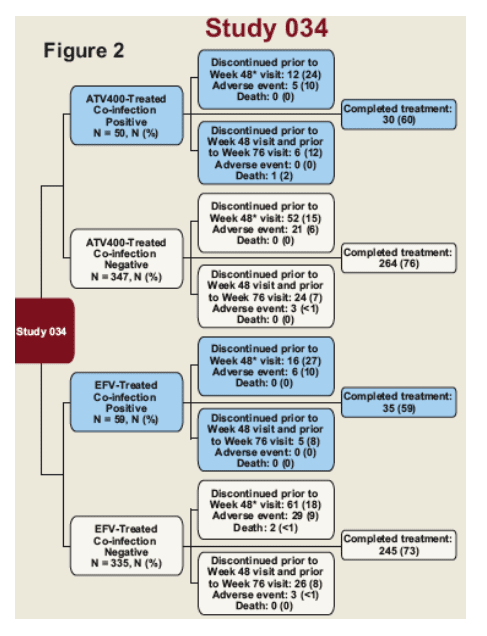
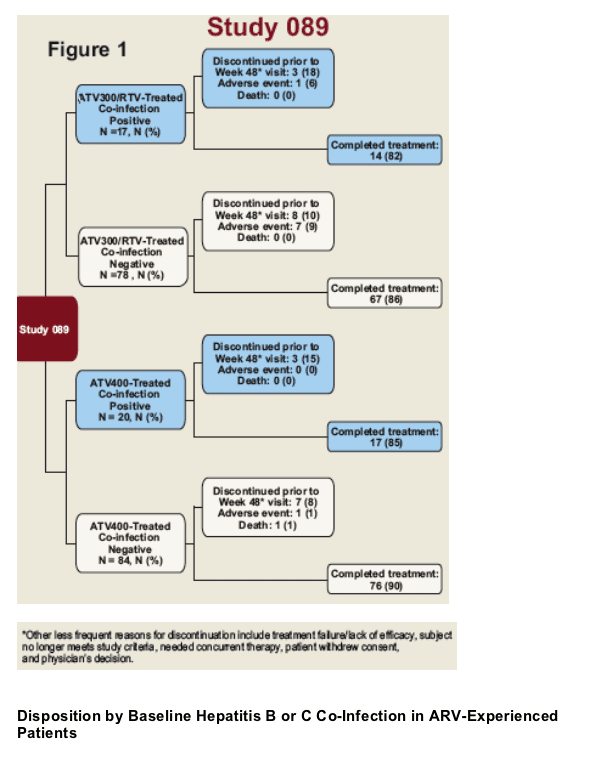
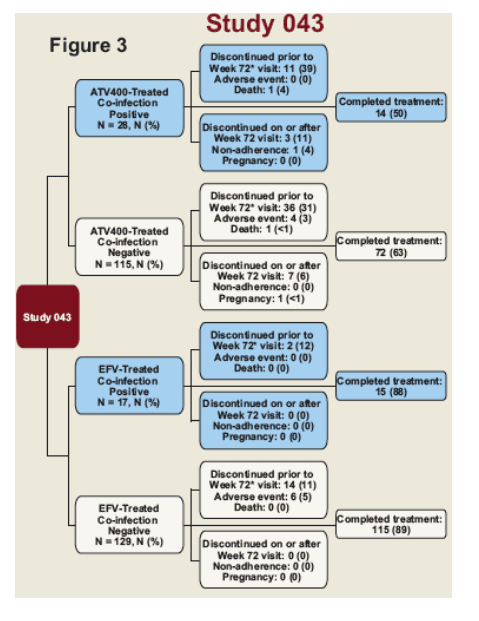

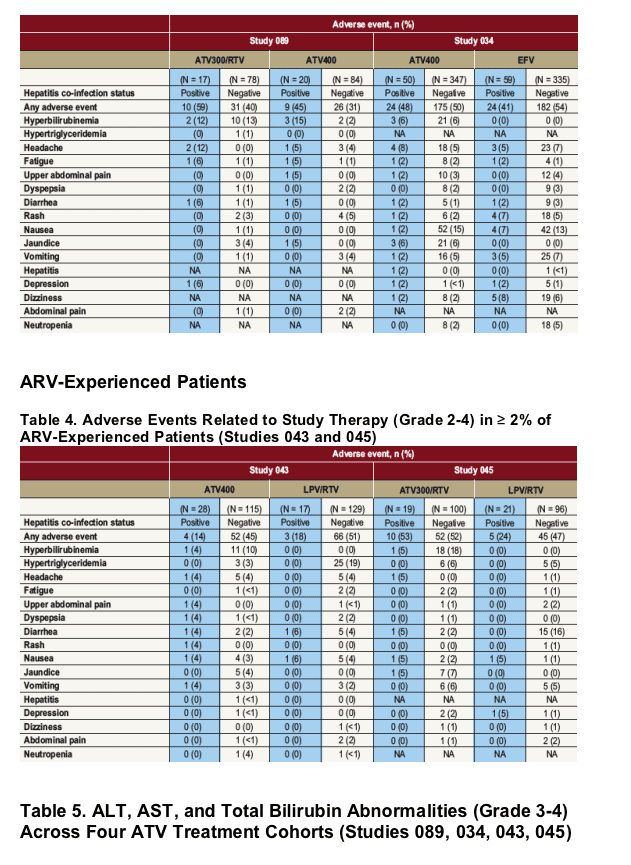
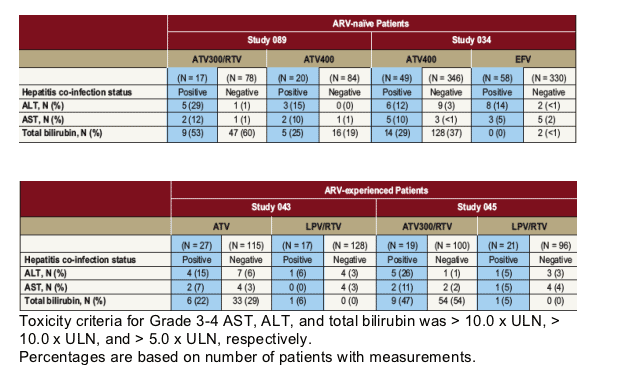
References
1. Sulkowski M, Thomas D, Mehta S, et al. Hepatotoxicity associated with nevirapine or efavirenz-containing antiretroviral therapy: role of hepatitis C and B. Hepatology. 2002;35:182-189.
2. Soriano V, Sulkowski M, Bergin C, et al. Care of patients with chronic hepatitis C and HIV co-infection: recommendations from the HIV-HCV International Panel. AIDS. 2002;813-828.
3. Squires K, Lazzarin A, Gatell JM, et al. Comparison of once-daily atazanavir with efavirenz, each in combination with fixed-dose zidovudine and lamivudine, as initial therapy for patients infected with HIV. J Acquir Immune Defic Syndr.
2004;36:1011-1019.
4. Barreiro P, Rendon A, Rodriguez-Novoa S, et al. Atazanavir: the advent of a new generation of more convenient protease inhibitors. HIV Clin Trials. 2005;6:50-61.
5. Aceti A, Caterina P, Zechini B, et al. Hepatotoxicity development during antiretroviral therapy-containing protease inhibitors in patients with HIV: the role of hepatitis B and C virus infection. J Acquir Immune Defic Syndr. 2002;29:41-48.
6. Perez-Elias M, Gatell J, Flores J, et al. Effect of ritonavir-boosted atazanavir (ATV/R) in experienced HIV-infected patients regarding chronic hepatitis B/C status. 3rd IAS Conference. Rio de Janeiro, 2005: Abstract TuPe1.1c25.
|
| |
|
 |
 |
|
|